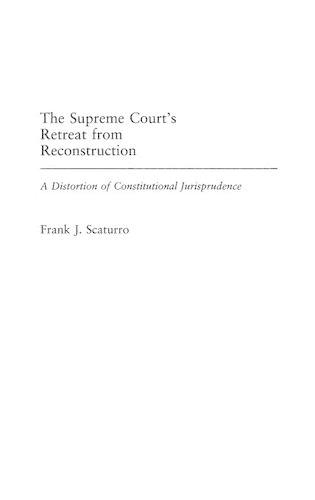
The Supreme Court's Retreat from Reconstruction: A Distortion of Constitutional Jurisprudence
(Hardback)
Publishing Details
The Supreme Court's Retreat from Reconstruction: A Distortion of Constitutional Jurisprudence
By (Author) Frank J. Scaturro
Bloomsbury Publishing PLC
Praeger Publishers Inc
30th March 2000
United States
Classifications
Tertiary Education
Non Fiction
Legal systems: courts and procedures
342.730873
Physical Properties
Hardback
320
Description
As the nation turned its back on Reconstruction, the Supreme Court in turn narrowed Thirteenth-, Fourteenth-, and Fifteenth-Amendment protections of former slaves, thus straying from the understanding of the amendments' framers. Tracking a long line of cases that employed narrow constructions of these amendments and accompanying statutes, this study compares the Court's propositions to the framers' own interpretations. The resulting portrait makes it clear that the Court contributed in a significant way to the nation's retreat from Reconstruction. Before analyzing the relevant cases, Scaturro provides a historical synopsis of the collapse of Reconstruction. The final section demonstrates how the twentieth-century Court handed down decisions that accommodated the demands of the Civil Rights Movement, but did so with constitutional interpretations that preserved several misunderstandings about the Reconstruction Amendments, especially the Fourteenth. This study helps to resolve a contemporary dilemma regarding the consequences of the Court's narrowing of the Interstate Commerce Clause. It also challenges long standing assumptions about the state action requirement of the Fourteenth and Fifteenth Amendments as well as the Fourteenth Amendment's Privileges and Immunities Clause. Besides being valuable to Supreme Court historians, the subject matter of this volume, which covers both constitutional law and legal history, will be of substantial interest to lawyers, judges, and political scientists, particularly in view of recent developments on the high Court. The lessons taught by this chapter of Supreme Court jurisprudence offer insight into constitutional interpretation in general, and the conclusion develops this idea by looking at the problematic interaction between law and outside historical influences.
Reviews
This book is worth reading....[t]he reader is rewarded with new evidence and an interesting perspective that support conclusions that while, not novel, are supported by the force of an excellent argument and by "connecting the dots" in a new way....This book is worth reading by academics and lawyers with the appropriate background in legal history, the Fourteenth Amendment or Reconstruction.-The Law and Politics Book Review
"This book is worth reading....the reader is rewarded with new evidence and an interesting perspective that support conclusions that while, not novel, are supported by the force of an excellent argument and by "connecting the dots" in a new way....This book is worth reading by academics and lawyers with the appropriate background in legal history, the Fourteenth Amendment or Reconstruction."-The Law and Politics Book Review
"This book is worth reading....[t]he reader is rewarded with new evidence and an interesting perspective that support conclusions that while, not novel, are supported by the force of an excellent argument and by "connecting the dots" in a new way....This book is worth reading by academics and lawyers with the appropriate background in legal history, the Fourteenth Amendment or Reconstruction."-The Law and Politics Book Review
Author Bio
FRANK J. SCATURRO is currently an associate at Cadwalader, Wickersham, and Taft in New York. With a lifelong interest in history, he founded the Grant Monument Association in 1994 to draw public attention to the disrepair of Grant's Tomb in New York City. He is the author of President Grant Reconsidered, and he has written articles in the fields of Supreme Court jurisprudence and American history, as well as civil procedure.
